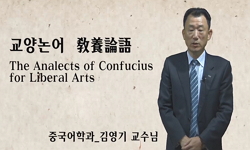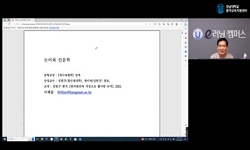『논어』는 유가의 비조인 공자의 언설이 기록되어 있는 경전이기에 동아시아 각국의 수많은 경학자들이 주석을 내곤 하였다. 이 중 가장 큰 영향력을 미친 『논어』 주석서는 朱子의 『論...
http://chineseinput.net/에서 pinyin(병음)방식으로 중국어를 변환할 수 있습니다.
변환된 중국어를 복사하여 사용하시면 됩니다.
- 中文 을 입력하시려면 zhongwen을 입력하시고 space를누르시면됩니다.
- 北京 을 입력하시려면 beijing을 입력하시고 space를 누르시면 됩니다.
退溪『論語』解釋의 經學的 特徵과 그 繼承樣相 = The Characteristic based on the Study of Confucian Classics of Interpretation of <the Analects of Confucius> of ToeGye and Its Aspect of Inheritance
한글로보기https://www.riss.kr/link?id=A45036968
-
저자
이영호 (성균관대 동아시아학술원)
- 발행기관
- 학술지명
- 권호사항
-
발행연도
2005
-
작성언어
Korean
-
주제어
논어 ; 주자 ; 논어집주 ; 퇴계 이황 ; 주자학파 ; 퇴계학파 ; the Analects of Confucius ; NoneoJipJu ; Chu Hsi ; ToeGye ; ToeGye school
-
KDC
100.000
-
자료형태
학술저널
-
수록면
203-251(49쪽)
- 제공처
-
0
상세조회 -
0
다운로드
부가정보
국문 초록 (Abstract)
『논어』는 유가의 비조인 공자의 언설이 기록되어 있는 경전이기에 동아시아 각국의 수많은 경학자들이 주석을 내곤 하였다. 이 중 가장 큰 영향력을 미친 『논어』 주석서는 朱子의 『論語集注』인데, 주자는 이 책에서 경전해석학의 중요 방법인 義理와 훈고를 반영해내었다. 그런데 주자 이후 중국의 주자학파는, 양명학과의 사상 투쟁 과정에서 그 자신의 정체성을 확립하고자 노력했기 때문에 자연히 주자의 경전해석방법 중 의리에만 치중하고 훈고는 소홀히 하였으며, 이러한 학문적 태도는 그들의 『논어』 해석에도 그대로 반영되었다.
한편 조선의 退溪는 『論語釋義』를 저술하면서 주자의 『논어』 주석을 준거로 삼았다. 때문에 그는 『논어』를 해석할 때 기본적으로 주자학적 의리에 충실하였지만, 때로는 經典의 本旨를 찾고자 노력했으며, 또한 경문의 자구를 조선어로 풀이하는 훈고에도 매진하였다.
퇴계 이후 영남 퇴계학파와 근기 퇴계학파는 주자와 퇴계의 영항 아래 각기 다른 경학적 특징들을 내포하는 『논어』 주석서들을 집필하였다. 영남 퇴계학파의 李德弘은 『論語質疑』를 통해 스승의 『논어』설을 준수하는 방향에서 『논어』를 해석했으며, 柳長源은 『論語纂註增補』에서 중국 주자학파의 『논어』설을 집성하였고, 柳健休는 『東儒論語集解評』에서 조선 주자학파의 『논어』설을 집대성하였는데 그 공통적 특징으로 주자학적 의리에 대한 정치한 분석을 들 수 있다.
한편 근기 퇴계학파의 종장인 李翼은 『論語疾書』에서, 주자의 의리정신을 높이 평가하였지만, 주자학적 의리와는 다른 새로운 의리-예컨대 현실과 이익의 중시-를 그의 『논어』해석에 투영시켰다. 또한 동아시아 『논어』 주석사에서 특기할 만한 『논어』주석서인 『論語古今註』를 남긴 丁若鏞도, 훈고만을 고집하는 한학을 배척하고 의리를 중시하는 주자학을 존숭하였다. 그러나 그 역시 이기심성론이 중심에 놓여있는 주자의 『논어집주』와는 달리, 『논어고금주』에서 경세치용을 지향하는 해석체계를 수립하였다.
주자가 『논어집주』에서 이룩한 훈고와 의리의 종합이라는 경학적 성과는 중국주자학파에서는 계승이 되지 않고, 조선의 퇴계에 와서야 계승이 되었다. 이후 퇴계학파는 의리를 중시하였다는 점에서는 중국의 주자학파와 별반 차이가 없다. 그러나 영남 퇴계학파의 경우는 주자학적 의리를 정치하게 파고들었고, 근기 퇴계학파의 경우는 조선후기 역사적 상황에 부합하는 새로운 의리를 그들의 『논어』 주석에 투영시켜 놓았다는 점을 차이점 내지 특색으로 들 수 있다.
다국어 초록 (Multilingual Abstract)
Many scholars in East Asian countries have written numerous annotations of <the Analects of Confucius> since <the Analects of Confucius> is the scripture that wrote down the remarks of Confucius who is a founder of Confucianism. Among all thos...
Many scholars in East Asian countries have written numerous annotations of <the Analects of Confucius> since <the Analects of Confucius> is the scripture that wrote down the remarks of Confucius who is a founder of Confucianism. Among all those annotations, the most influential annotation of <the Analects of Confucius> is the <NoneoJipJu> written by Chu Hsi. Chu Hsi reflected the scholia and trend of focusing on contents in the context which are important methods for the studies of scripture interpretation. The Chu Hsi school in China after Chu Hsi, however, had tried to establish its identity during the philosophical dispute with the Wang Yangming school. The philosophical dispute with the Wang Yangming school made the Chu Hsi school to focus on not scholia but trend of focusing on contents in the context. The Chu Hsi school's attitude towards trend of focusing on contents in the context had been reflected on their interpretation of <the Analects of Confucius>.
Meanwhile, ToeGye in Choson used the Chu Hsi's annotation of <the Analects of Confucius> when he wrote <NoneoSukEui>. He was basically loyal to the way of focusing on the contents in the context. But sometimes he tried to make an effort to find out the original meaning of the scripture. He also made an effort to scholia that translated the sentences of the scripture in Choson language
After ToeGye, YoungNam ToeGye school and KeunKi ToeGye school had written several annotations of <the Analects of Confucius> that included different characteristics based on the study of Confucian Classics under the influence of Chu Hsi and ToeGye. Lee, DukHong in YoungNam ToeGye school interpreted <the Analects of Confucius> with the accordance of his master's theory in his book, <NoneoJilEui>. In his book, <NoneoChanJuJeongBo>, Yoo, JangWon compiled the theories of <the Analects of Confucius> of Chinese Chu Hsi school. Yoo, KeonHyu collected the theories of <the Analects of Confucius> of Korean Chu Hsi school in his book, <DongYuNoneoJipHaePyung>. Their common characteristics were based on finding out the contents in the context of the scripture.
Meanwhile, the master of KeunKi ToeGye school. Lee, Ik had a different view of the trend of finding out the contents in the context of the scripture from that of Chu Hsi although he highly evaluated Chu Hsi's spirit for finding out the contents in the context of the scripture. He developed a new way of finding out the contents in the context of the scripture - for instance, putting on the importance of reality and profit - in his annotation of <the Analects of Confucius>. Chong, Yagyong who wrote <NoneoKoKeumJu>, that was a special annotation of <the Analects of Confucius> in the history of annotation of <the Analects of Confucius> in East Asian countries, excluded exegetical studies and showed his respect to the studies of Chu Hsi classics.
Having Difference from Chu Hsi's <NoneoJipJu> that focused on less practical issues, he, however, built on the interpretational system that pointed to practical usage of running the state in his <NoneoKoKeumJu>.
Chu Hsi's scholaristic outcome that combined scholia and the way of focusing on the contents in the context had been succeeded not in Chinese Chu Hsi school but in Choson Chu Hsi school. The ToeGye school made little difference with the Chinese Chu Hsi school in terms of putting on the importance on the way of focusing on contents in the context of the scriptures. YoungNam ToeGye school, however, was different from the Chinese Chu Hsi school in terms of studying the way of focusing on contents in the context of the scriptures in detail. KeunKi ToeGye school was different from Chinese Chu Hsi school in terms of developing new theory of seeing the way of finding out the contents in the contexts of the scriptures. That new theory corresponded to the historical situation in the late era of Choson dynasty.
목차 (Table of Contents)
- 1. 서론
- 2. 퇴계의 『논어』 해석과 그 경학적 특징
- 3. 퇴계학파의 『논어』 해석과 그 分化의 樣相
- 4. 결론
- 1. 서론
- 2. 퇴계의 『논어』 해석과 그 경학적 특징
- 3. 퇴계학파의 『논어』 해석과 그 分化의 樣相
- 4. 결론
동일학술지(권/호) 다른 논문
-
- 慶北大學校 退溪硏究所
- 김인철
- 2005
-
- 慶北大學校 退溪硏究所
- 조기호
- 2005
-
- 慶北大學校 退溪硏究所
- 성해준
- 2005
-
- 慶北大學校 退溪硏究所
- 김석배
- 2005




 RISS
RISS






